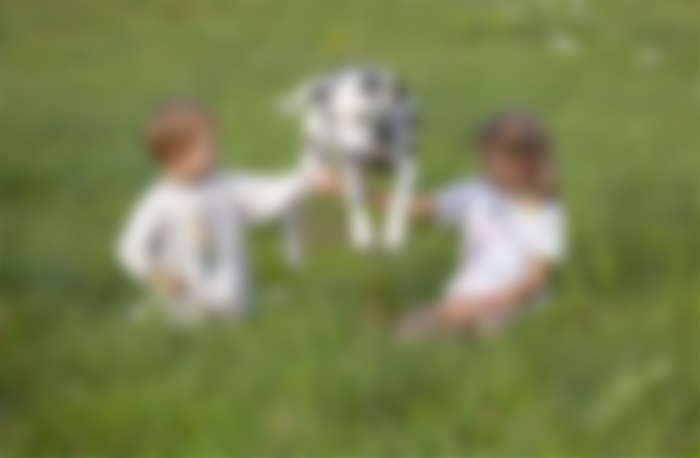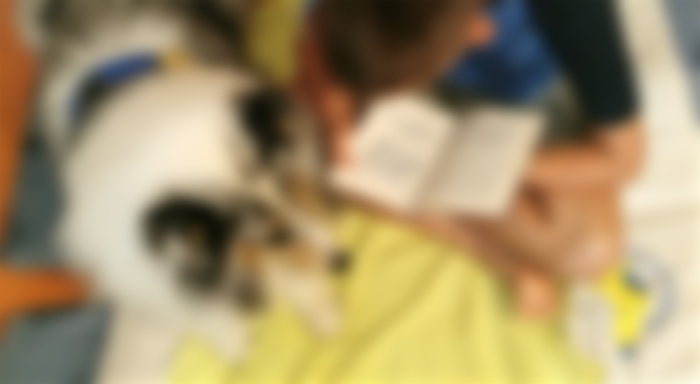Many experts have already realized that the presence of a dog is very beneficial to a child's development. When they grow up together, they learn from each other and become best friends over the years. But from the first day, for example, the child must know that he must not pull the puppy by the tail, that he is not a toy, that he must leave him alone when he sleeps, that he must not let him eat cookies, etc.

Positive effects of the dog on the child
A child and a dog bring double joy to the family, the house is always full of joy and fun. If a child grows up with a puppy, he develops a sense of responsibility, and he can also learn a lot from it. They are completely equal, so growing up together is all the more fun. A child growing up next to a four-legged friend behaves more genuinely, down to earth. He is also characterized by being very independent, not so nervous, coping with stressful situations more easily and, in principle, having a very calm character.
How should a child behave towards a dog?
The most important thing is that the child knows from an early age that the dog is not a toy, that he should not put necklaces, hats, sunglasses, etc. on it. The puppy should not be yelled at, pulled by the tail or ears, ridden or beaten!
The dog also needs his peace. When he sleeps, the child should not bother him. He should also not be disturbed when he is. It is also important to point out that the puppy does not eat cookies, figs, chips, etc., that he has his own, dog food.
Commands, rules, prohibitions, what the dog can and should not, the child must also know. He needs to know the words that you also say when you want to say something to the puppy.
The bitch is respected! A child can show him in many ways that he loves him - by caressing him, praising him for taking him for a walk, running around with him, giving him fresh water to drink, brushing him…
"Paw helpers "- dog heroes who help children discover their best selves
In the society for therapy with the help of dogs "Paw helpers" I have been an active therapeutic couple with my dog Divo for eight years. We are dedicated to working mainly with children and people with special needs. The work done by therapeutic couples, which consists of a guide and a dog, as a volunteer activity, leaves invaluable traces in young people and adults.
I will write you a nice experience:
"The younger student had an extremely strong fear of public speaking. He was not ready to read anything aloud in front of his classmates, nor did he want to answer the teacher's questions. The child was suggested to read the poem aloud to the puppy. After the first fairly quiet words, the reading became louder and louder. The next day, the child read the same song with the dog's photo aloud to the teacher, and the same child had already performed at the school celebration at the end of the school year."

Less than 14 years ago, the founders of the association certainly did not imagine that we would become one of by far the largest such associations.
The work of therapy dogs is very special given their active role, environment and the people involved in the therapy hour. Such skills must be learned by dogs, and even earlier by their handlers, so that they can be properly guided and taken care of for their complete safety, as well as the safety of other participants. The dog is a collaborator in the therapy hour and not a tool for achieving goals, so we want him to be happy to do the assigned work.
Therapeutic dogs must master many skills, such as walking between the guide and the user on a relaxed leash, holding different positions (standing, sitting, space, lying on your side…), walking in a wheelchair, pole, crutches, walker, they must not be afraid to climb on chair, table or bed, followed by walking up the stairs, through the straits, back and forth and in a circle, using the elevator, changing rooms with different smells, recognizing the gestures with which the guides command them, without voice commands, must be patient, obedient…
The breed is not important, mixed breeds are also suitable, and quite a few of them are also adopted from shelters in our species. In addition to the above, the dog must be at least one year old, bred, trained with a companion dog exam or a B-BH exam, a loving companion, tolerant, adaptable, mentally and physically stable.
Children are actively involved in the activity, are patient and extremely motivated, no matter what task they have to perform. Suddenly, nothing is difficult for them. From their faces and eyes radiate a single joy, enthusiasm, kindness, desire for personal contact with the dog. When our dogs show them some of the dog's skills at the end of the class, the day becomes perfect for the children,
Therapeutic dog guides in introductory meetings teach and raise awareness of children and adults with "abc rules of conduct" in the presence of a dog, which are very important and must be strictly observed by those present. I will mention only some of the most important ones that need to be considered always and everywhere if there is a dog hairy in the immediate vicinity. It is really worth remembering and strictly considering the following in particular:
- we always ask the dog's guide if we can approach the dog and pet it,
- we teach them about the correct approach to the dog (we approach him from the side), but we always pet him from the neck to the tail (if we push our fingers towards his eyes, he feels uncomfortable and withdraws - we would do the same),
we never jump, scream, or make sudden movements near the dog,
- never disturb the dog during sleep, eating food without prior warning (talking to the dog),
- we do not take food or toys from the dog without prior warning (when we give him something, he understands that it is his),
the dog is an extremely big responsibility, it is not a toy, it is also a financial burden on the family budget - the latter especially in case of illness,
- the dog is a sentient being, so we must provide him with adequate care (suitable living space - the dog is not for the chain),
we acquaint children and adults with proper nutrition, care and veterinary care,
we remind you that the training of a guide and a dog is absolutely necessary if we want to have an educated, socialized and loving family member,
- in the event of a dog showing signs of growling or possible danger of attack, it must not be looked in the eye, screamed, make sudden movements, run… - avoid possible attack by complete rest or very slow lateral movement,
- we introduce children to "dog professions" (police dogs, guide dogs for the blind, guide dogs, rescue dogs, therapy dogs…). In particular, we emphasize that these dogs should never be gossiped or disturbed while performing their tasks (for example, we disturb the guide dog of the blind and he can make a mistake that can even be fatal for his guide).
I have listed just a few of the really most basic rules that kids and adults should know. The latter should behave especially responsibly and be aware that a child should never be left near a dog without adult supervision. Man is to blame for all unloved events and accidents. Improper dog reactions are merely a response to distracting stimuli.
How the R.E.A.D. - We read with "paw" and what are the effects of this kind of reading for both children and puppies?
With the R.E.A.D. (Reading Education Assistance Dogs) was started in 1999 by members of the American Society of ITA (Intermountain Therapy Animals). Today, it is already widespread in 26 countries with approximately 1,600 active therapeutic couples licensed by R.E.A.D. The "Paw helper" association has been a member of ITA since 2011 and membership is a condition for a therapeutic dog guide to be able to take a written exam at a distance after prior professional training. Currently, our society, with 38 therapeutic couples who also hold an R.E.A.D. license, is the largest in the world.

The basic purpose of the program is to help children master and consolidate reading skills with the help of an unusual listener - a therapy dog. Children who read to a dog become better readers, improve speaking, reading and communication skills, gain reading pleasure, self-confidence, strengthen positive self-esteem, gain self-confidence, improve comprehension of read content, forget about their reading problems or other personal limitations. Reading helps the dog to eliminate the fear of public appearances and at the same time children become more socially skilled, less vulnerable, and more easily involved in other activities. For children, reading to a dog is exciting and a special experience for them. Since the child has left the reading class with only positive emotions and experiences, he wants the dog to read again. Of course, a loyal listener deserves the best, fluent reading possible, so the experience motivates reading at home as well.
One more experience
"Paw helpers" during therapies face great challenges as well as successes that are achieved with the help of therapy dogs. Example: in one of the primary schools, a child from the first triad was included in a therapy class with a dog, who would be happy to delete a mathematics subject from the school schedule, even though he was successful in other subjects. So we agreed that the dog will help to overcome the resistance to in this case anything but a beloved object. We only needed a therapy dog that was on the table, a sewing meter, a pencil and paper. The child measured the dog’s leg length, tail, torso circumference, and so on. We started adding, multiplying, dividing all the recorded measurements… Since all the numbers were tied to a specific dog, addition, subtraction became fun and interesting, the schoolboy was led by curiosity about how long the dog's ear is and how long they are both together and the like. Solving math problems with the dog became fun and enjoyable. Why the child experienced an almost miraculous turnaround is difficult to explain. In any case, it is true that in the presence of a therapy dog everything is different, because everything takes place relaxed, fun, spontaneous…
Undoubtedly, we are proud of the fact that a dog can be an exceptional co-therapist in the process of treatment and rehabilitation and in strong support and support, especially for people with special needs, which neither the professional nor the lay public believed at the time of the association.

Thank you for reading.

Greetings.
@Kaya





Hey, I didn't know dogs could be so beneficial! Maybe in a couple of years I might obtain a little four legged friend hehe.
Once Upon A Spunky Developer